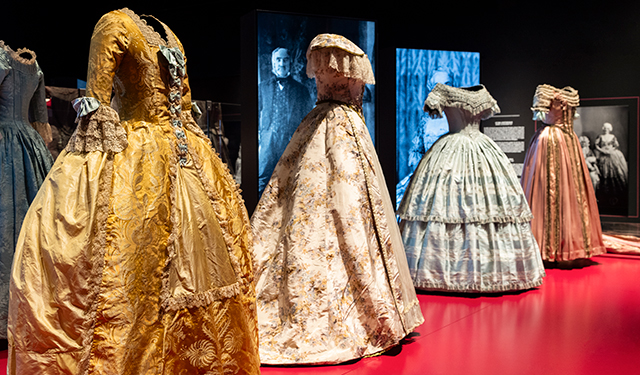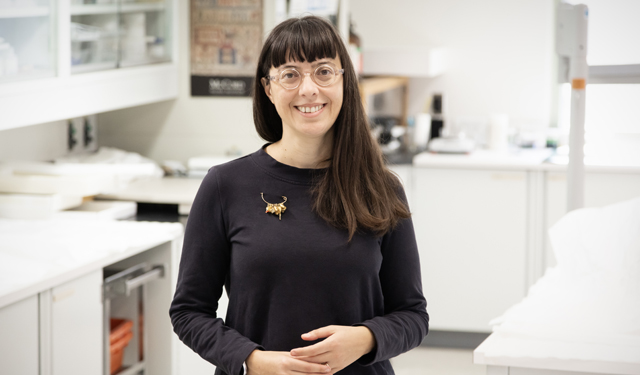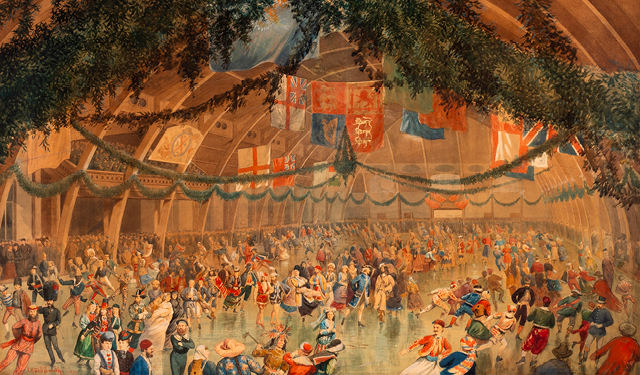[Day 1] Costume Balls: The Symposium
A wide range of approaches to the unparalleled material and visual legacy featured in the exhibition Costume Balls: Dressing Up History, 1870-1927.
March 20, 2025
The extensive historical record of the practice of dressing up assembled in the exhibition documents the minutia of lighthearted moments of life a century and more ago. Yet matters of far greater historical significance continue to be unsettled through the study of a phenomenon so ephemeral and seemingly inconsequential. What current questions have arisen from deep engagement with the material? How has that process opened up new methodological terrain?
The McCord Stewart Museum’s specialists but also curators, artists and authors share new learning derived from the full spectrum of the process of creating the exhibition, from the slow curatorial process of identification and analysis of the extant garments and visual culture, through the subsequent rethinking of our objectives for conservation interventions, to addressing historical injustices in impersonations of Indigeneity.
Keywords: Museology | Textile conservation | Material culture | Indigenous cultures | Costume history | Photography history | History of Canada and Quebec (19th century) | Exhibition curation.
This recording includes the four talks from March 20, 2025. View the day’s program below, and browse the video using the available chapters to watch the session of your choosing.
Session 1 – Incursions in the Archive
Slow Research: The Unfolding of a Lifetime Project
Moderated by Cynthia Cooper
[ 11:10 ]
Costume Balls contains a visual and material legacy of astonishing breadth and depth. How is it that the Museum’s collections have come to hold so many historical objects and images documenting ephemeral moments of enjoyment? After conducting the deliberate research that led to a Master’s thesis completed in 1994, followed by a book and exhibition in 1997, I was satisfied that my work had uncovered most of the material and visual culture that existed in archives and museum collections relating to the practice of fancy dress balls in Canada. And yet, in my two and a half decades since then at the McCord Stewart Museum, I have continued to discover much more, seemingly serendipitously. I propose to explore this latter phase of “slow research” as a growth process, whereby the skills honed by my earlier work for the close reading of material culture and historical images have been developed by my ongoing exposure to larger volumes of such material. Moreover, this process has been accompanied by an ever-broadening awareness of the repertoire of popular Eurocentric references and the everyday manifestations of colonialism, imperialism and white supremacy so common in the late 19th and early 20th centuries.
Photographing phantasmagoria
Moderated by Cynthia Cooper
Zoë Tousignant, Curator, Photography
[ 1:13:00]
In the late 19th century, composite photography was commonly used to depict large groups at fancy dress occasions. For the people photographed, the composite was a commemorative object that celebrated (and offered proof of) their participation in an extraordinary and, in many cases, once-in-a-lifetime event. Given the strict conventions regulating all aspects of society life in the late 19th century (including what to wear and how to behave at a costume ball), this type of photograph was an ideal mode of representation. It allowed photographers to satisfy the demands of mass consumers while cultivating reputations built on relationships with clients positioned at the top of the social ladder. Eminently malleable, these images could be shaped to communicate the required message of social respectability, despite the presence at these events of a handful of non-conformist characters likely to attract controversy.
Through the Ground Glass: Reframing William James Topley
Moderated by Cynthia Cooper
Rebecca Basciano, Curator, Ottawa Art Gallery and Chun Hua Catherine Dong, Artist
[1:54:00 ]
This presentation will explore how historical narratives can be reimagined through contemporary art. By means of a conversation examining the intersections of photography, performance, and cultural memory, it will highlight the evolving role of historical archives and their influence on contemporary artistic practice.
Using the recent Ottawa Art Gallery exhibition Through the Ground Glass as a focal point—where historical works by William James Topley were presented alongside contemporary artists, including panelist Chun Hua Catherine Dong—this discussion will examine Dong’s engagement with Topley’s photograph of Mr. William A. Allan in costume for the Governor General’s fancy dress ball of 1876, wearing what he claimed to be traditional Chinese attire. The conversation will focus on Dong’s initial reaction to the archival image, their creative process, and the layered meanings embedded in their reinterpretation, which culminated in the photographic series Unmask Opera (2023). With this work, Dong confronts racial and gender stereotypes embedded in colonial photography, offering a powerful discussion of history, identity, and the politics of visibility.
Session 2
Bringing the Exhibition to Life: Families, Digital Content and Photography
Moderated by François Vallée, Head, Exhibitions
Laura Dumitriu, Senior Photographer, Elysa Lachapelle, Project Manager, Education, Community Engagement and Cultural Programs and Stéphanie Poisson, Head, Digital Outreach, Collections and Exhibitions
[2:37:00 ]
Costume Balls: Dressing Up History, 1870-1927 is a major exhibition that mobilized a variety of expertise from the Museum’s different teams. Moderated by François Vallée, Head, Exhibitions, this panel discussion will elucidate the respective roles played by Laura Dumitriu, Senior Photographer, Stéphanie Poisson, Head, Digital Outreach, Collections and Exhibitions, and Elysa Lachapelle, Project Manager, Education, Community Engagement and Cultural Programs, in preparing the exhibition. The panellists will discuss the way in which photography helped disseminate and document the exhibition content, the role of digital content and immersive technologies in enriching the visitor experience, and the creation of an interactive family tour designed to enable visitors of all ages and backgrounds to explore the exhibition.
Biographies
Cynthia Cooper
Cynthia Cooper, Head, Collections and Research, and Curator, Dress, Fashion and Textiles, holds an MS in Historic Costume and Textiles from the University of Rhode Island. Her research centres dress and fashion that have become entangled with Canadian identity projects, ranging from nineteenth-century fancy dress and court dress to twentieth-century children’s coats and regional tartans.
François Vallée
François Vallée, Head, Exhibitions, has led the team since 2023. In addition to supporting his department’s activities, he helps develop the Museum’s rich and varied programming. Since joining the Museum in 2019 as a project manager for exhibitions, he has overseen several exhibitions on a variety of topics. He holds a BA in history and an MA in museum studies from Université du Québec à Montréal (UQAM).
Zoë Tousignant
Zoë Tousignant, Curator, Photography, holds a PhD in Art History from Concordia University and an MA in Museum Studies from the University of Leeds. As a researcher and curator, she focusses on the production and reception of photographic culture in Quebec and Canada.
Rebecca Basciano
Rebecca Basciano is Chief Curator at the Ottawa Art Gallery (OAG), where she supports artistic practices through curating exhibitions, publishing catalogues, acquiring works, and facilitating touring exhibitions. Her most recent curatorial projects, which employ strategies of inclusion and diversity, have offered counter-narratives and examined the intersection of historical and contemporary art.
Chun Hua Catherine Dong
Chun Hua Catherine Dong (she/they) is a Chinese-born Tiohtià:ke/Montréal-based artist. Dong’s work has been exhibited at many national and international venues. A finalist for the Musée national des beaux-arts du Québec Contemporary Art Award in 2020, Dong received the Cultural Diversity in Visual Arts Award from the Conseil des arts de Montréal in 2021, and was long-listed for the Sobey Art Award in 2024.
Laura Dumitriu
Laura Dumitriu, Senior Photographer, is in charge of photographing objects from the collection for documentation and dissemination purposes. Since joining the Museum in 2016, she has contributed to twenty or so exhibitions and several catalogues. She has developed expertise in digitizing and digitally restoring glass negatives, as well as preparing images for printing. She holds a diploma in photography from Humber Polytechnic and a certificate in journalism from Concordia University.
Elysa Lachapelle
Elysa Lachapelle, Project Manager, Education, Community Engagement and Cultural Programs, creates mediation activities to make exhibitions more accessible to all types of audiences. Since joining the Museum in 2020, she has used her interest in families as a target museum audience to develop her expertise by designing tours and activities especially for them. She earned both a BA and an MA in art history from Université du Québec à Montréal (UQAM).
Stéphanie Poisson
Stéphanie Poisson, Head, Digital Outreach, Collections and Exhibitions, has developed digital production expertise to create immersive exhibition experiences both in the galleries and online. She has coordinated several groundbreaking, large-scale digital projects, which involve digitizing objects, making them accessible online, and creating distribution platforms. She holds a BA in art history and an MA in museum studies from Université de Montréal.



